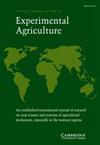Maize grain and straw yields over 14 consecutive years in burned and mulched Mucuna pruriens var. utilis and Pueraria phaseoloides relay cropping systems
IF 1.9
4区 农林科学
Q1 Agricultural and Biological Sciences
引用次数: 1
Abstract
Abstract The cover crops Mucuna pruriens var. utilis and Pueraria phaseoloides were introduced to African farmers to improve crop production on degraded soils, yet they appear not to be adopted at scale. In the humid forest zone of West and Central Africa, the dominant Acrisols and Nitisols are inherently poor even when not degraded through agriculture. In this zone, sole maize cropping and vegetable production systems are gaining importance, yet both suffer from nutrient deficiencies. Cover crops were often introduced along with a system change, requiring biomass retention, mainly for nutrient retention reasons. Farmers in the zone commonly use slash and burn systems due to added weed control and ease of operations on clean fields. This study evaluated mucuna and pueraria with and without burning the fallow biomass in an annual sole maize crop relay system against the burned and retained natural fallow. Over 14 consecutive years, biomass burning did not cause lower maize grain yields in any of the fallow types, on the contrary, the economically important marketable cob yields were higher when biomass was burned (mulched 2.10 cobs m−2 vs. 2.26 cobs m−2 when burned, p < 0.07). After cover crop fallow, maize grain yields were significantly higher than after natural fallow (1.92 Mg ha−1) over the 14 years, with maize yields in the pueraria treatment (2.63 Mg ha−1) out yielding those in the mucuna treatment (2.28 Mg ha−1). Maize produced 1.92 cobs m−2 in natural fallow, significantly less than in the mucuna (2.23 m−2, p < 0.013) and the pueraria (2.39 m−2, p < 0.001) fallow. Introducing mucuna or pueraria cover crops into slash and burn systems appears as a suitable measure to increase yields without changing the land preparation approach.玉米籽粒和秸秆连续14年的产量在燃烧和覆盖的土葛和相葛根接力种植系统
为了提高退化土壤上的作物产量,非洲农民引进了覆盖作物Mucuna pruriens varo . utilis和葛根(Pueraria phaseoloides),但它们似乎没有被大规模采用。在西非和中非潮湿的森林地带,即使不通过农业进行退化,占主导地位的acrisol和Nitisols也天生贫瘠。在这个地区,单一的玉米种植和蔬菜生产系统越来越重要,但两者都存在营养不足的问题。覆盖作物通常是随着系统变化而引进的,需要生物量保持,主要是出于养分保持的原因。该地区的农民通常使用刀耕火种系统,因为它增加了杂草控制,并且在清洁的田地上易于操作。本研究评估了在每年一次的玉米作物中继系统中,有无燃烧的休耕生物量对燃烧和保留的自然休耕的影响。在连续14年的时间里,生物质燃烧没有导致任何一种休耕类型的玉米产量下降,相反,具有重要经济意义的可销售穗轴产量在生物质燃烧时更高(覆盖2.10穗轴m−2比燃烧2.26穗轴m−2,p < 0.07)。覆盖作物休耕后14年的玉米产量显著高于自然休耕后的产量(1.92 Mg ha - 1),葛根处理的玉米产量(2.63 Mg ha - 1)远高于粘土处理(2.28 Mg ha - 1)。自然休耕地玉米的穗轴产量为1.92 m−2,显著低于粘地(2.23 m−2,p < 0.013)和葛根(2.39 m−2,p < 0.001)休耕地。在刀耕火种系统中引入粘草或葛根覆盖作物似乎是在不改变土地准备方法的情况下提高产量的合适措施。
本文章由计算机程序翻译,如有差异,请以英文原文为准。
求助全文
约1分钟内获得全文
求助全文
来源期刊

Experimental Agriculture
农林科学-农艺学
CiteScore
2.50
自引率
6.20%
发文量
29
审稿时长
24 months
期刊介绍:
With a focus on the tropical and sub-tropical regions of the world, Experimental Agriculture publishes the results of original research on field, plantation and herbage crops grown for food or feed, or for industrial purposes, and on farming systems, including livestock and people. It reports experimental work designed to explain how crops respond to the environment in biological and physical terms, and on the social and economic issues that may influence the uptake of the results of research by policy makers and farmers, including the role of institutions and partnerships in delivering impact. The journal also publishes accounts and critical discussions of new quantitative and qualitative methods in agricultural and ecosystems research, and of contemporary issues arising in countries where agricultural production needs to develop rapidly. There is a regular book review section and occasional, often invited, reviews of research.
 求助内容:
求助内容: 应助结果提醒方式:
应助结果提醒方式:


